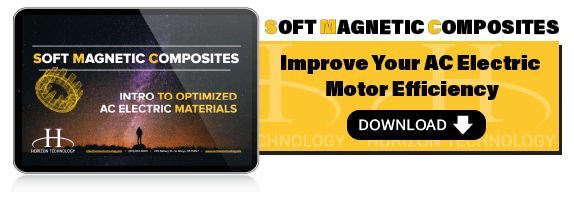The global pandemic created disastrous societal and commercial disruptions. Commercial issues were highlighted by supply chain interruptions leading to delays or cancelations in the manufacturing, shipping, and distribution of semi-finished and finished goods. The semiconductor chip shortage alone, resulted in the loss of >10 million vehicle builds loss of >10 million vehicle in the US.
Electric motors play a key role in everyday living from home goods, to hand tools, to the electrification of the automobile and aviation. This increased demand puts new pressure on the supply chain. Add to this, the pressure for increased efficiency (reduced energy consumption) - forcing a shift to higher performing lamination steels. These trends are consigning greater emphasis on regionalized supply chains to support manufacturing. Consequently, manufacturers must reevaluate sourcing of their basic materials and subassemblies - maintaining greater control of their production while minimizing unacceptable business risks.
If you’re not taking electrical steel availability as seriously as the chip shortage, you should be. John Anton, director of pricing and purchasing at IHS Markit, recently gave a grim outlook:
“Producers have been notified that they will be on allocation, essentially rationing, for electrical steel for all of (2022), with most expecting to get only 80% to 90% of purchase requirements. The impact of the electrical steel shortage could potentially be as damaging to the global economy in 2022 and 2023 as the semiconductor shortage (was in 2021).”
This scarcity could certainly impact the ongoing “electrification” of transportation. Other products and industries feeling the pinch of material shortages are:
- Household motors/appliances
- Power tools
- Lawn & garden equipment
Implications of this shortfall can be dramatic. What if you only make 8,000 of an order instead of the 10,000 your customer really wanted? Someone with the right technology or availability (such as alternative soft magnetic composite or sintered soft magnetic materials) might grab up the other 2,000. Potentially, in the long-term replacing you as a potential supplier.
What’s the Deal with Electrical Steel? State of the Shortage in 2023
Electrical steel (often called silicon steel) has been at the heart of improved electrical motor efficiency trends for many years. This iron alloy possesses strong magnetic properties, and is key to efficiently converting electrical energy into mechanical energy.
Data from Metals Technology Consulting indicates that capacity constraints of these silicon steels will get serious this year. And from 2025 onward, it’ll be “highly unlikely” that mills can meet demand without adding significant investment in NOES (non-oriented electrical steels)..jpg?width=680&height=382&name=Electrical%20Steel%20Blog%20%20(5).jpg)
The question is: Why the Shortage and How Can I Overcome this Shortfall?
Why Is the Electrical Steel Shortage Happening?
Expanding ‘Electrification’
Government emissions regulations and consumer demand are driving the need for “electrified” solutions in automotive and other markets. To make these devices run efficiently (low core loss and high permeability), engineers require specialized electrical steels.
High Concentration in Asia
Mills that manufacture electrical steel exist primarily in China.
In part due to the ambitious vehicle electrification goals across the globe, OEMs are fighting over limited regional sources of steel.
The global electric motor markets already rely on Asia for rare-earth magnets and other products. Add in electrical steel, and that’s a lot of eggs in one basket.
High Barriers for Producers
It’s a long road for a company to break into or expand into electrical steel manufacturing.
Mills aren’t created in a day – in the best of times, it takes 3 to 5 years to:
- Acquire permits
- Engineer
- Get construction equipment
- Build
And that’s for an established supplier! A new vendor will probably need an extra 2-8 years before it’s ready to produce these silicon grade steels, according to IHS.
The saying “It’s hard to find good help” also extends to actually stamping the laminated silicon steel sheets that form a final part. Only 20 companies that specialize in motor core lamination stamping exist worldwide, and even fewer producers of the stamp press equipment itself.
Limited Alternatives
Again, not just any slab of metal will do for demanding applications that require high magnetic performance. Electrical steel laminations are often a key element in motors generating high torque and high efficiency.
Note that “laminations, or nothing at all” is largely a perceived limitation. Viable alternatives exist, even if some engineers don’t realize it … yet. More on that in a bit.
How the Electrical Steel Shortage Hurts Manufacturers
The projected forecast for worldwide motors is expected to grow according to the chart below, driving electrical steel demand. Currently, over 85% of the global electrical steel supply is sourced from Asia - setting up a potential supply chain issue within a deglobalized economy
-png.png?width=641&height=481&name=electric-motor-market%20(1)-png.png)
Prototyping and launch plans become a nightmare when you’re stuck waiting for materials. There’s less time to figure out what worked and didn’t work, and less time to return to the drawing board.
In reality - it’s not lamination steel or nothing at all – your answer is something as simple as Soft Magnetic Composites (SMC).
How SMCs offset the Electrical Steel Shortage
Necessity breeds innovation.
OEMs and Tier 1 suppliers look for design loopholes that allow them to completely rethink their design concepts. Changing the simple 2D planar geometry of a rotor or stator to a 3D shape - improving performance, while reducing the overall bill of material cost by more than you might realize.
Even better, it allows you to avoid electrical steel altogether …
When reimagining your motor design with SMC you can focus on advantages such as:
- Higher torque density by filling all available space
- Maximize the effectiveness of copper windings in your design
- Reducing the amount of magnet material required
- Minimize waste normally associated with stampings of laminations
- Reduction of the overall size and weight of the motor without compromising torque density
- SMCs are a proven green technology reducing energy costs by 17% compared to electrical steel laminations and can be easily recycled
What are Soft Magnetic Composites?
Soft magnetic composites (SMCs) represent a subset of the ferrous Powder Metal (PM) industry. SMCs are created by utilizing high purity iron powder that is coated with an electrically insulating layer. Then by utilizing PM compaction technology, a unique 3D shape is created that can offer excellent higher frequency AC performance.
The powder metallurgy (PM) industry is capable of meeting the demand of today’s top performing electric motors – todays best solution is soft magnetic composite (SMC).
By directly partnering with an experienced SMC manufacturer having materials and processing expertise, you can improve your current motor design and stabilize your supply chain.
Again – necessity breeds innovation. Let the experts at Horizon work with you to reimagine your motor - from concept to production.
To learn more about AC electric motor materials and SMC, download this free e-book:



